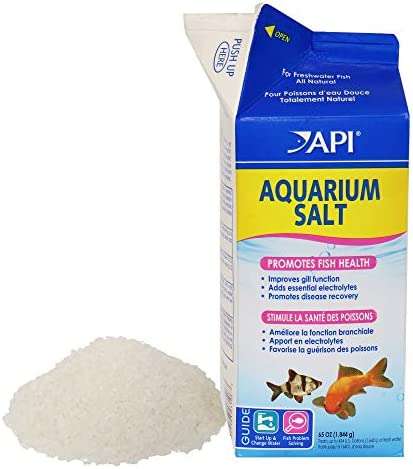I purchased this API aquarium salt for it’s healing properties in my freshwater Betta tank. He was coming down with a tiny section of fin rot because of poor water quality for a short period of time. This, along with very frequent 25%-50% water changes helped heal his fin rot. (The water changes alone may have worked fine, but I wanted to add salt for extra help in regrowth.)
I really only have 2 complaints:
1- The granules vary, but some are quite large. Even by adding them to a small cup of boiling water and stirring frequently it took several minutes to properly dissolve. If not dissolved properly and added gradually it can burn your fish!
2- The directions are not very clear. They are listed in 3 languages, so that’s nice, but there is plenty of room for more clarity on dosing your tank. (The product label is on 2 of the 4 sides so they could actually use another side for information to add clarity.) It states that you can either add 1 rounded tablespoon for every 5 gallons OR 1/2 rounded teaspoon for every gallon. The fist measurement gives you a 1 tbsp to 5 gallon ratio while the second measurement give you a 0.83 tbsp to 5 gallon ratio. I guess it’s trying to be helpful for those with a tiny bowl or small hospital tank??? It mentions NOTHING about dissolving the salt first or adding it gradually. If you are treating your fish and don’t happen to learn that in your own research, then you may end up just plopping the measurement into your tank and harming your fish.
***I do appreciate that it mentions that some live plants may not tolerate the salt. I chose to risk it and many did ok. They didn’t grow much, but didn’t seem harmed. A few did lose leaves and kinda melt away though. I simply removed those that were not tolerating the salt for the time being.
***I also appreciated the packaging mentioning that the salt does not evaporate so be careful not to compound it. For example, when I did a 25% water change, I dissolved and added 25% of the salt I had previously dosed my tank with to the new dechlorinated water.
Compared to other retailers the price is good considering the volume you get. Plus the convenience of not going to a store is nice.
NOTE ON TREATING BETTA FIN ROT:
(Just thought I’d add this in hope that it might be helpful for someone.)
Fin rot is common, so don’t feel horrible if you are dealing with it. Doing lots of research before any treatment is very important! Anyone can type anything on the internet that information will pop up in a google search. Read lots of different opinions, watch many reputable/informative videos and do your best to understand why your Betta has fin rot in the first place.
If you don’t have a heater or filter this is the first change your should make when combatting fin rot. All Bettas (even healthy ones) with benefit from these tank additions. (If your house temperature NEVER falls below 78F you may not need need a heater, but most of us do for at least part of the year. It can easily be unplugged or removed when not needed.) Bettas don’t like a strong current so a sponge filter works great. If you have a filter that is built into your aquarium or came with a set, there probably an easy way to baffle it for your Betta’s comfort. I added an aquarium sponge to the output of mine.
Your could be biting it’s own fin which looks like bites taken out opposed to a fraying or melting of the fins. This often happens on the caudal (think tail) fins pretty much in line with where your Betta’s mouth could reach. You may even observe your Betta seemingly “chase its tail.” My research tells me this often happens when a Betta is unhappy so consider if your tank is large enough. Betta’s enjoy stimulation so a Betta leaf, hide and silk plants are an easy addition to try if you don’t already have them.
The fin damage could be caused by sharp objects in the tank. This may look like a tattered or ripped fin. Betta fins are very delicate. It’s good to check all decorations thoroughly by rubbing your fingers over them. You can possibly alter them to make them safe (like sanding down a rough area of driftwood) but be sure that only soft items are in your tank. Even some plastic plants may be damaging your Betta’s fins so many people recommend silk or live plants only.
Unclean water may have caused your fin rot. Even if it looks clear to you, it may be full of harmful ammonia, nitrites or nitrates. If you don’t have a test kit, investing in one will help keep your Betta healthy. The API master test kit provides LOTS of tests and is very accurate.
For me, I learned that I was not cleaning my tank the best that I could. I house 1 male Betta and 2 Nerite snails in a 5 gallon planted tank. Nerite snails help with algae, but they also poop a lot, so there was lots of animal waste my tank. Because I have a planted tank and was trying to allow some plants to carpet the bottom, I did not agitate my substrate enough when cleaning. I was also not consistent with my weekly water changes when work got busy. Big mistakes that led to a little fin rot.
Along with 25% weekly water changes to reduce waste it is important to gravel vac the detritus up from your tank so that bad bacteria does not grow in your substrate. Use your siphon to press down into the substrate. Once you see lots of substrate getting pulled up (along with the detritus) lift the siphon a few inches out of the substate and give it a wiggle. This should release the substrate but allow the detritus to continue up the tubing. (If substate gets caught and slows down suction it can easily be removed by taking out your siphon and piking it with a clean wooded skewer.) If you are working around plants, do this method to the exposed substrate only. Wiggle the vac or use a clean/unused wooden chopstick or skewer to agitate around the substate of your plant. This will make the detritus start to float into the water and you can suck it up there.
I also find it helpful to take a new toothbrush that I have designated for tank cleaning to the leaves of my plants. I noticed some brown algae (diatom) buildup forming on them. I initially thought they may be dying, but the brown layer came off easily and once removed it helped them grow better. On smaller leaves I just gently rubbed it off with my fingers. I use the same brush to scrub off my driftwood. You can use it on the inside glass of your aquarium too if you have a large buildup of algae, but if not then you don’t need to.
I have moss glued to my driftwood so I use my hands to agitate that and sometimes pull or trim off excess or weakened growth. This helps encourage new growth. I plop any removed moss into an open mason jar full of dechlorinated water and set it on the window sill to grow more fresh green algae over a month or so. Sometimes I replace that water and sometimes I top it off with a splash of old aquarium water for some plant nutrients.
It is also important to note that if you have any uneaten food (pellets that fall or messy bits from a frozen food feeding) you should pull out your siphon and remove them within a few minutes. They will pollute your tank and cause problems for your fish (and you).
Sometimes you have to learn the hard way, but cleaning your tank is often more involved than just scooping out some water once in a while! Good luck with your fin rot and don’t forget to do your research!
Click to expand…
Our pond isn’t large enough for
For now, we’re just focusing on keeping these two comets healthy inside for the winter/however long they need to be inside.
Had to weigh in on this Ich issue. Heat isn’t a good remedy for dealing with this parasite. Heat will shorten the lifespan of the parasite, but it also stimulates the fishes’ metabolism. This means they’ll poop more and further foul the tank water. Aquarium plants won’t tolerate really warm water. Keep the water temperature at its normal setting. Actually, Goldfish don’t need a heater in their tank. If you keep your house temperature at around 68 to 70 degrees, the fish will be fine without one. Add some standard aquarium salt to your replacement water. Two teaspoons for every 5 gallons of treated tap water is enough to retard the growth of this parasite and stimulate the fishes’ immune system. It will also ease the stress on a sick fish. Change half the water a couple of times a week and vacuum the bottom material. Keep the food to a minimum. A little every couple of days is enough to sustain the fish. Follow this procedure until you see improvement in the fish.
Old
Click to expand…
I don’t have aquarium salt on hand for using this water change, but I’ll get some today. I’ll be adding
Thank you for all the advice, this is very helpful.
Is it safe to use all these together: Seachem Prime, Seachem Stress Guard, Kordon Rid Ich Plus, and aquarium salt?
I’m having trouble finding a store that sells Kordon Rid Ich in my area. I could order it, but then I have to wait longer to treat my fish.. other medicine recommendations?
I would feel better waiting and getting something recommended in a couple days than just grabbing something off the shelf, but if I can find something else to use right away (that is recommended) I’d feel even better about it.
EDIT: I was calling around some more places and found some Kordon Rid Ich, but I’m still not finding anywhere that has Seachem Stress Guard (even though pretty much all of them carry Seachem products). Is it safe to medicate without something like this? Is there another brand you’d recommend?
Our pond isn’t large enough for koi and husband chose comet goldfish since they should be able to handle winters here just fine, but there are a lot of things that could be wrong with the pond right now and since we don’t know what, we brought these last two in (there were 2 fan tails that never should have been in there to begin with and there was 1 other comet that didn’t make it). We’re not worrying about the pond until after winter, then we’ll do tests, make needed changes, and consider trying again.For now, we’re just focusing on keeping these two comets healthy inside for the winter/however long they need to be inside.I don’t have aquarium salt on hand for using this water change, but I’ll get some today. I’ll be adding Seachem Prime . I have two kinds of sea salt but they both have an additive to prevent caking, so I doubt it’s safe..Thank you for all the advice, this is very helpful.Is it safe to use all these together: Seachem Prime, Seachem Stress Guard, Kordon Rid Ich Plus, and aquarium salt?I’m having trouble finding a store that sells Kordon Rid Ich in my area. I could order it, but then I have to wait longer to treat my fish.. other medicine recommendations?I would feel better waiting and getting something recommended in a couple days than just grabbing something off the shelf, but if I can find something else to use right away (that is recommended) I’d feel even better about it.EDIT: I was calling around some more places and found some Kordon Rid Ich, but I’m still not finding anywhere that has Seachem Stress Guard (even though pretty much all of them carry Seachem products). Is it safe to medicate without something like this? Is there another brand you’d recommend?




